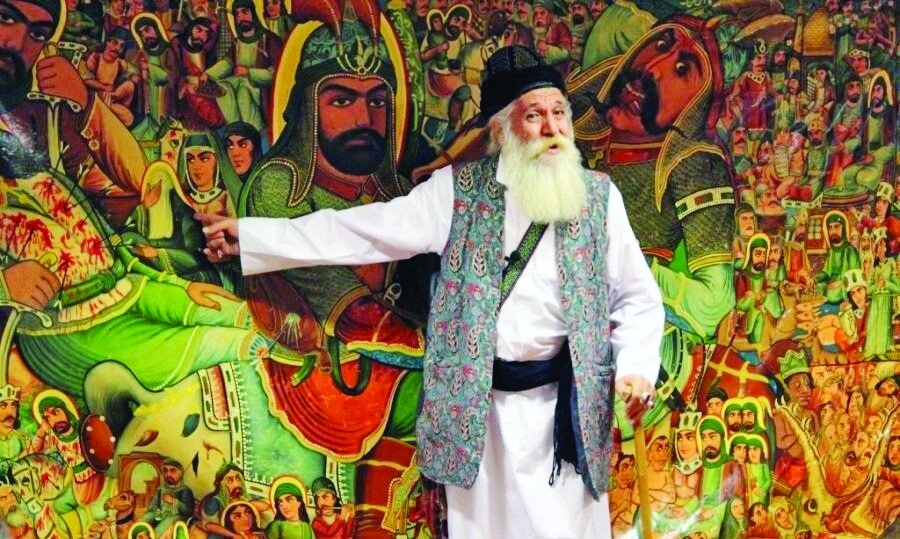Storytellers who give life to illustrations on large canvas

TEHRAN – Iran has always been home to avid storytellers who use that powerful medium to take us to the past, to the future, or to exotic worlds filled with new sights, sounds, smells, and feelings.
Pardeh-khani (literally, "reading aloud from the screen/from the curtain"), is one of those skills through which storytellers give life to illustrations on a large canvas.
The time-honored dramatic form of art is still occasionally performed across the country to commemorate the slaying of Imam Hussein (AS), grandson of the Prophet Mohammed (PBUH), in the battle of Karbala in 680 CE.
Pardeh-khani is a type of storytelling combined with a laudation that is always accompanied by pictures. It is probably acting like an educational- entertainment media to form a kind of stream of consciousness for audiences to virtually travel to different times and places.
There are illustrations on a large canvas named parde, and a person called pardekhan (storyteller or minstrel) stands before the crowd, points to an illustration with a stick, and narrates its story. This was a kind of street art and people, mostly children, and teenagers, would gather in a square, where pardekhan would tell his stories. With a long wooden stick, he would show the images and at the same time would tell the story of each majlis (act).
According to an article published by the Shanghai Academy of Fine Arts of the Shanghai University, encountering two-fold forces for creating an attractive situation on one hand and making audiences aware of the mysteries of the world, on the other hand, are the most important features of this art. The contrast between death and life, past and future, good and evil, holy people and cruel ones, war and peace, lightness and darkness, and physical and metaphysical forces all form deep concepts which are the main elements of the purposeful business of Pardeh-Khani art, reflected both in the context of stories and in the contents of the pictures painted on curtains and those who are in charge of presenting this show including painters, storytellers and minstrels follow such concepts. Accordingly, the main objective of this study is to clarify the unknown corners and aspects of this business as a deep-rooted and noble art.
Each canvas comprised several parts called majlis, and each majlis had its own story, which was also part of the main story. Most narratives came from one of these two sources: the story of Imam Hossein (AS) and Shahnameh by Ferdowsi, the great Persian poet who composed the epic poem.
Pardeh-Khan had performed his work every evening in fields, teahouses, and crossroads, and in general, in the places in which people congregated and rest. All glitterati and common people respected him.
Since ancient times, Iranian culture was the source of thought and was considered a tool for transferring affections and, in general, was the factor adapting humans to the environment and other people.
The completion trend of Pardeh-Khani and Shabih-Khani as social, religious, divine, and artistic approaches was started when the Shia religion became stronger in the Qajar era. Pardeh-khan always emphasized the educational and upbringing aspects of stories and he used to employ different techniques for obtaining this object. Of course, in earlier times, religious stories were narrated verbally, but over time music and images were also employed for more impressive purposes.
The curtains were painted with simple pictures, without any naturalism and shading techniques and traditional perspectives, which were being utilized in them to emphasize the ideological and religious aspects to impress deeply the audiences. Breaking down space, time and situations is one of the most important characteristics of the art of Parde-Khani resulting in a kind of suspension and postponement in the story. Another characteristic of this art is the encounter of twofold forces clarifying the deep and complex concepts hidden in them. This duality and contrast allow the audiences to analyze the messages of curtains and select their path. The existence of a kind of hidden agreement between the contrast subjects painted on curtains causes the audiences to understand relations between forces and promote their general awareness.
This great work of art which has great integration with the culture, tradition, and religion of Iranian has been inherited generation by generation so far that we can see this art as public art in the streets of Iranian cities on special days and months such as Muharram for Muslims all around the world as well as traditional Iranian festivals.
The main purpose behind this work is to familiarize the younger generation with mythical characters from ancient Iran such as Rostam and Sohrab.
AFM
